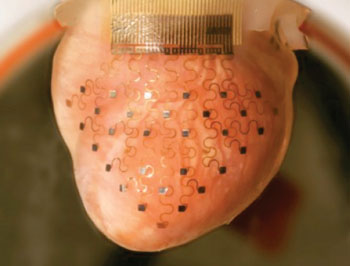Implanted Sensor Membrane Monitors Heart’s Health
By HospiMedica International staff writers
Posted on 20 Mar 2014
A printed, custom-fitted, implantable device with embedded sensors could transform the treatment and prediction of cardiac disorders. Posted on 20 Mar 2014
Researchers at Washington University in St. Louis (WUSTL, MO, USA) and the University of Illinois (Urbana-Champaign, USA) have created a three-dimensional (3-D) elastic membrane made of a soft, flexible, silicon material that is precisely shaped to match the heart’s epicardium. The membrane is fitted with embedded sensors, made of several semiconductor materials including silicon, gallium arsenide, and gallium nitride, along with metals, metal oxides, and polymers.

Image: 3-D printed membrane with embedded sensors on a rabbit’s heart (Photo courtesy of WUSTL).
Because it is implantable, the elastic membrane could be used to monitor diseases of the ventricles in the lower chambers of the heart, for example by including a troponin sensor that could assist physicians determine heart health and warn them of an impending heart attack, before any physical signs become evident. In the case of heart rhythm disorders, it could be used to stimulate cardiac muscle or the brain. The study was published online in on February 25, 2014, in Nature Communications.
“Currently, medical devices to treat heart rhythm diseases are essentially based on two electrodes inserted through the veins and deployed inside the chambers,” said lead author Professor of Biomedical Engineering Igor Efimov, PhD. “Contact with the tissue is only at one or two points, and it is at a very low resolution. What we want to create is an approach that will allow you to have numerous points of contact and to correct the problem with high-definition diagnostics and high-definition therapy.”
“Each heart is a different shape, and current devices are one-size-fits-all and don’t at all conform to the geometry of a patient’s heart,” added Professor Efimov. “We image the patient’s heart through MRI or CT scan, then computationally extract the image to build a 3-D model that we can print on a 3-D printer. We then mold the shape of the membrane that will constitute the base of the device deployed on the surface of the heart.”
Related Links:
Washington University in St. Louis
University of Illinois














